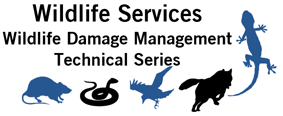United States Department of Agriculture: Animal and Plant Health Inspection Service

Wildlife Damage Management Technical Series
Date of this Version
8-2016
Document Type
Article
Citation
Wildlife Damage Management Technical Series, U.S. Department of Agriculture, Animal & Plant Health Inspection Service, Wildlife Services, August 2016
Abstract
Canada geese, snow geese, ducks, and American coots all have been implicated in agricultural crop and turf damage. Canada geese and snow geese that graze on winter wheat and rye crops can reduce subsequent grain and vegetative yields. Canada geese also cause serious damage to sprouting soybeans in spring and to standing cornfields in the autumn. The most common damage to agricultural resources associated with geese results from consumption of crops. Other impacts involve unacceptable accumulations of feces in pastures, trampling of emerging crops, and increased erosion and runoff from fields where the cover crop has been grazed. Canada geese graze on a variety of crops, including alfalfa, barley, beans, corn, soybeans, wheat, rye, oats, spinach, and peanuts, sometimes resulting in significant reductions in yields. Since the dramatic increase in snow goose populations, there has been extensive damage to their breeding habitat in the in the Arctic and tremendous grazing pressure on exposed crops and vegetation during the early spring migration. Most damage results from grubbing, trampling, and uprooting and occurs along the migration route on the eastern coastal areas, and in the mid-western and southern states. In addition, agricultural producers are concerned that geese spread noxious seeds to crop and pasture lands and reduce livestock forage. During the fall, winter, and early spring, large flocks of ducks and American coots migrate into California where they damage small grains and alfalfa. Most damage is from grazing on alfalfa or sprouting grain. In the fall, large flocks of ducks and American coots alighting in un-harvested rice fields trample and consume the crop. Prior to the 1990s, ducks and geese had been reported to cause as much as $6 million to $10 million in damages to grains that are swathed and laid on the ground before harvesting. Most of this damage occurred in the Canadian Provinces and Dakotas. However, changes in harvesting techniques in the 1990s from swathing to straight- or stripper-cutting have greatly resolved the problem. Migratory Canada geese, ducks, and American coots on their winter range have become acclimated to urban environments where they graze on domesticated grasses in parks, golf courses, highway rights-of-way, sport fields, and similar locations. Damage and economic costs at these locations varies by species, numbers, and concentrations, but can be substantial. For example, damage to putting greens by geese, ducks, or coots can cost thousands of dollars to repair or replace.
Included in
Behavior and Ethology Commons, Biodiversity Commons, Other Animal Sciences Commons, Other Ecology and Evolutionary Biology Commons, Population Biology Commons, Terrestrial and Aquatic Ecology Commons


Comments
US government work